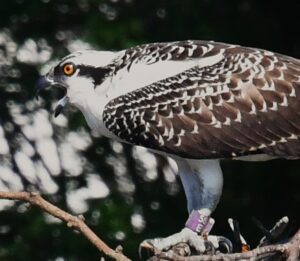
By Mary Reid Barrow
Photos by Reese Lukei
Researchers and even those of us who walk the trail to the Narrows in First Landing State Park know that there have been fewer and fewer young osprey in recent years along the Lynnhaven River.
Recent news articles also have reported on the decline in nest production in the river and in the Chesapeake Bay.
Working from a boat with Keriann Spiewak, researcher from the Virginia Aquarium, raptor expert Reese Lukei has been conducting osprey surveys on the Lynnhaven for the Center for Conservation Biology in Williamsburg for more than 40 years.
Recently Reese compared the number of baby ospreys that fledged from nests that they were able to follow from start to finish in 2019 and 2025.
“There’s been a serious decline in production,” he said.
Reese retrieved the data on 51 active osprey nests in 2019.
“One hundred and forty eggs were laid and 79 survived to fledge,” he said. “A success rate of 56 percent.”
In 2025, the researchers were able to complete surveys of 42 active nests. One hundred and nineteen eggs were laid and only 19 young survived to fledge.
“A rate of 16 percent,” Reese said.

No one really knows yet what the causes are. It could be a lack of food. Ospreys are strictly fish eaters and there has been a decline in menhaden in the Bay, but menhaden are not a big source of food for osprey in the Lynnhaven, Reese said.
Reese mentioned the growing eagle population. Eagles will harass ospreys and rob them of the fish they have caught which results in less food for their nestlings.
Predators of eggs and baby osprey include crows and great horned owls, and last year, a nest camera on the Lynnhaven even revealed a mink raiding an osprey nest at night!
From tests that have been conducted on dead young, Avian Flu is not a suspect, Reese said.
Ospreys prefer dead or dying trees for nests where branches don’t obstruct the 360-degree view the birds like, Reese said. Such trees are few and far between on the river where not many homeowners relish the thought of dead or dying trees in their yards.
The U.S. Coast Guard also has removed several channel markers where ospreys used to nest, but artificial platforms are a good substitute for tree snags and channel markers.
On the other hand, several of the manmade nesting platforms on the water are way too small to accommodate the 4-foot wingspan of a young osprey, Reese said. When it exercises its wings it can knock a sibling into the water to drown. A standard nesting platform is 4-by-4 feet in size and directions can be found on the Internet.
In addition to adding properly built osprey nesting platforms to the river, residents with a view of an osprey nest can join a network of osprey watchers around the world, sponsored by the Center for Conservation Biology. Add observations, photos and notes on your nest to OSPREYWATCH: https://www.osprey-watch.org
Read this most recent media interview with Bryan Watts, director of the Center for Conservation Biology, here Osprey decline in VA signals broader environmental problems.
